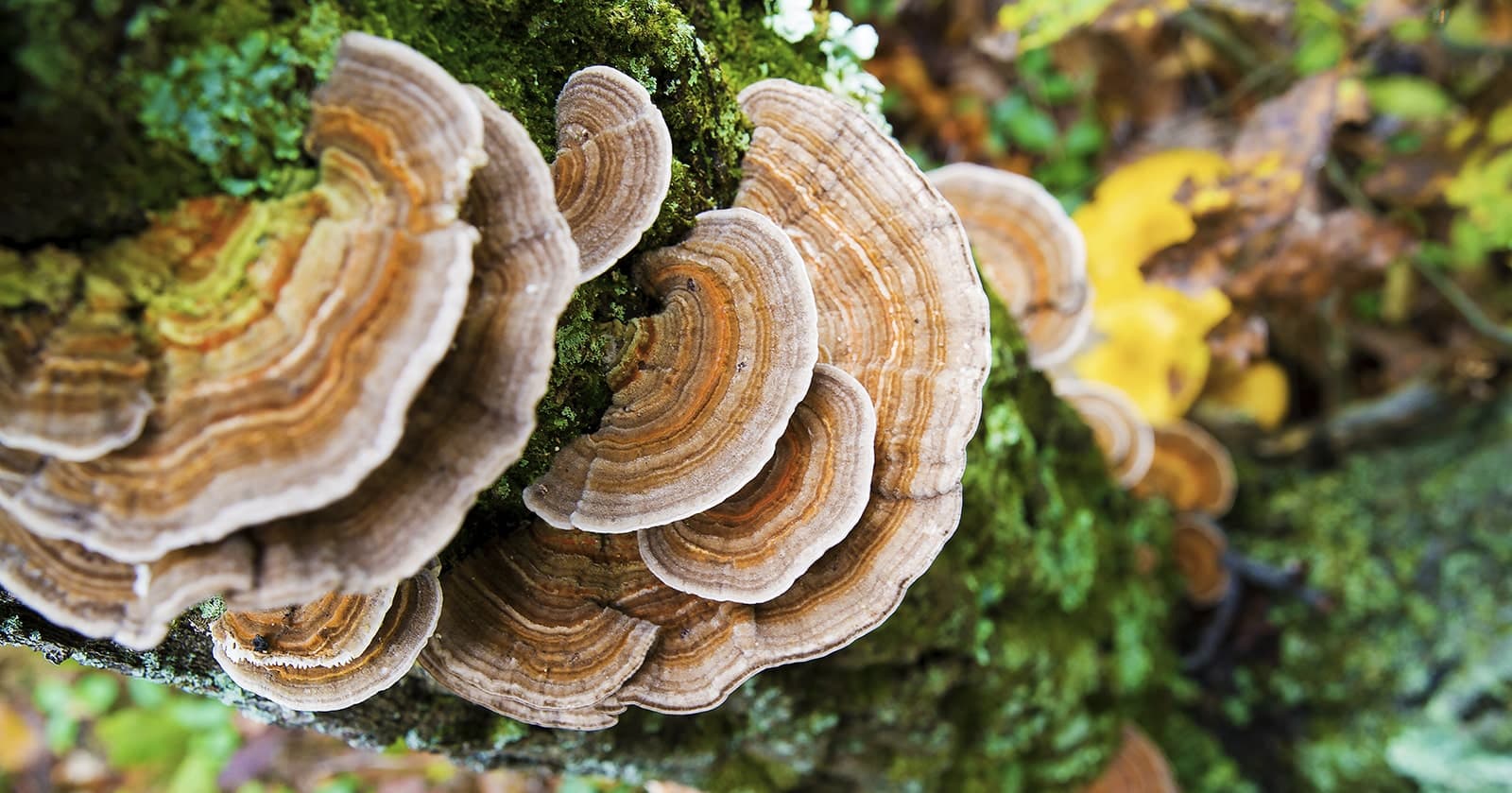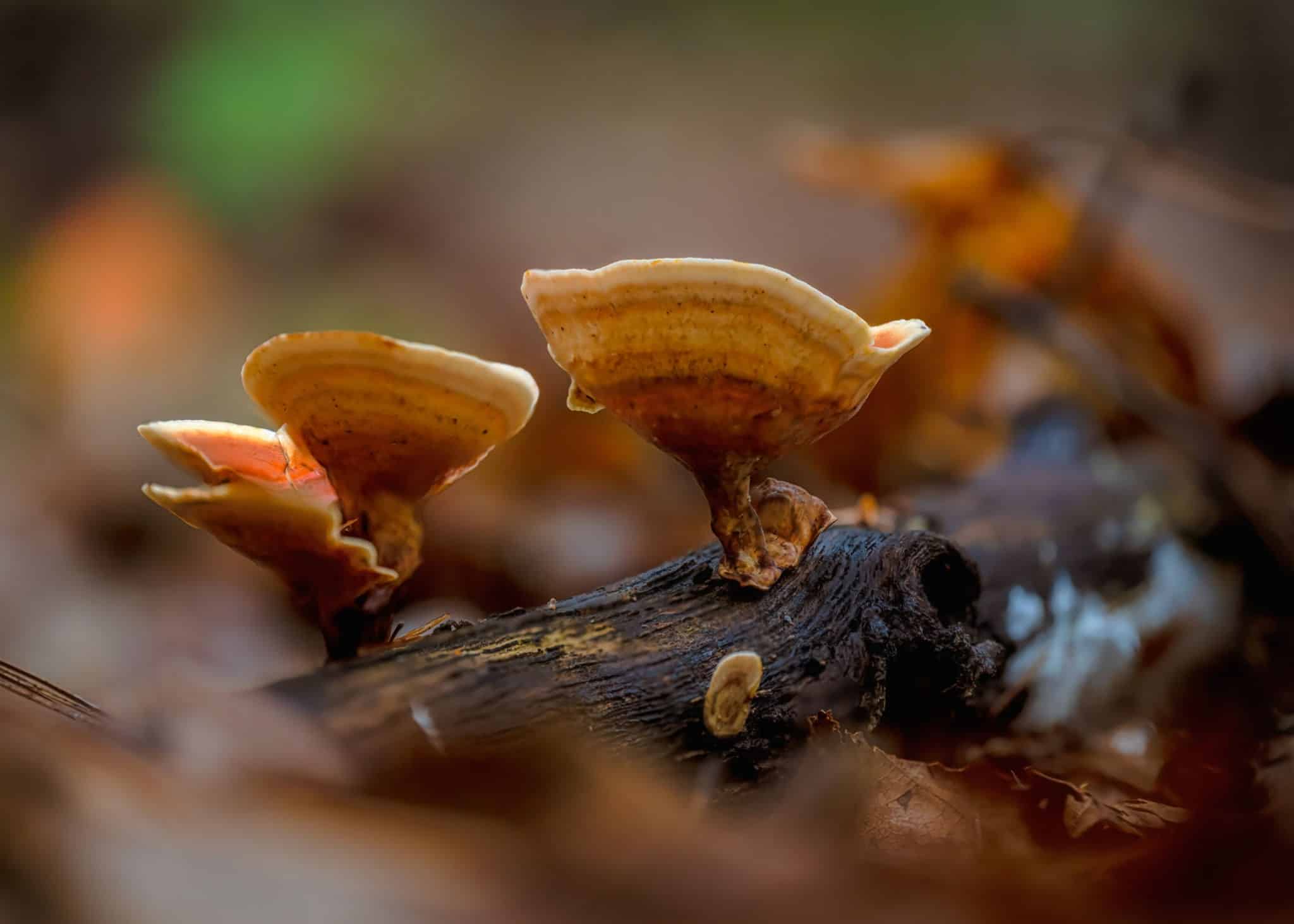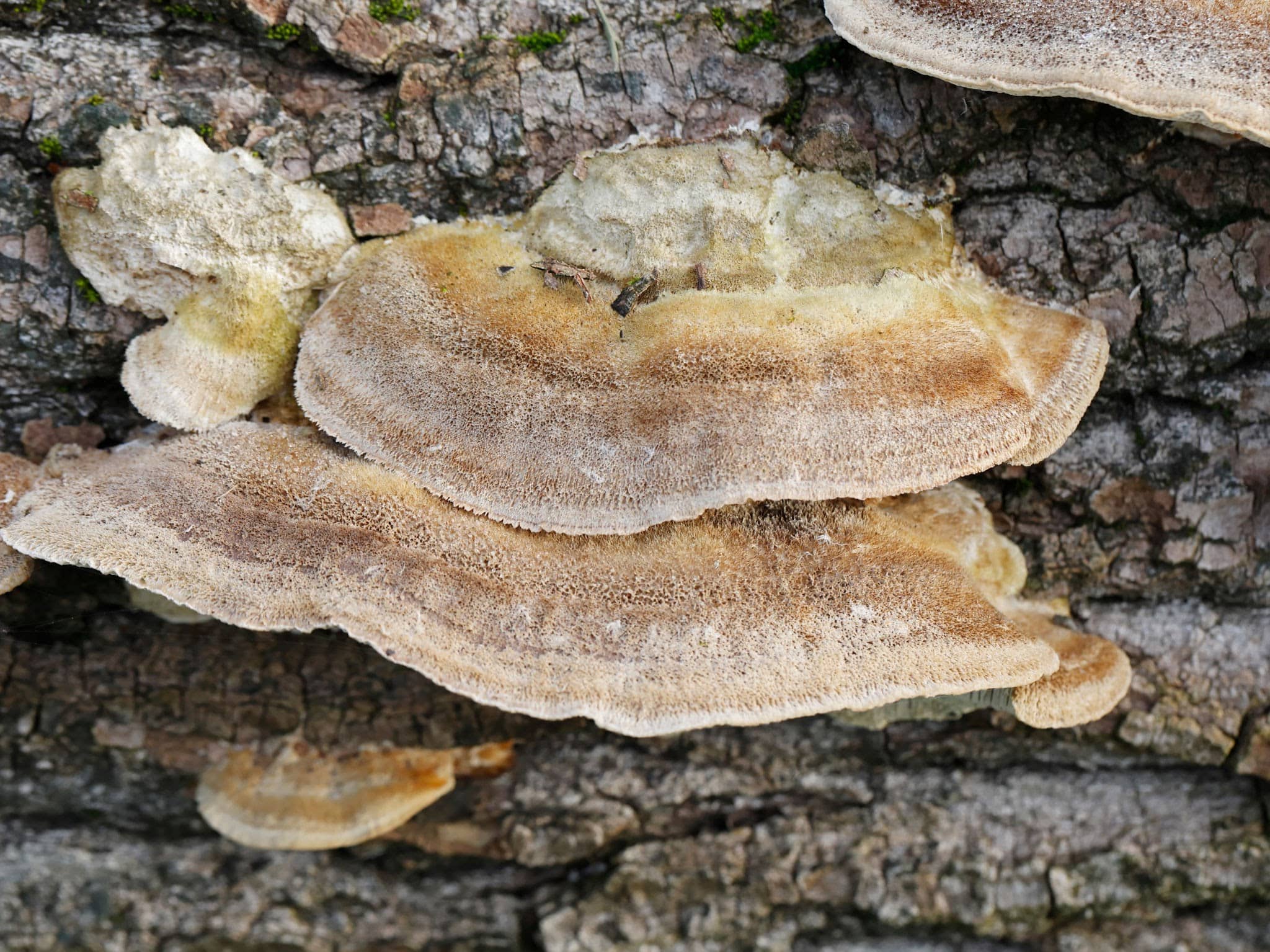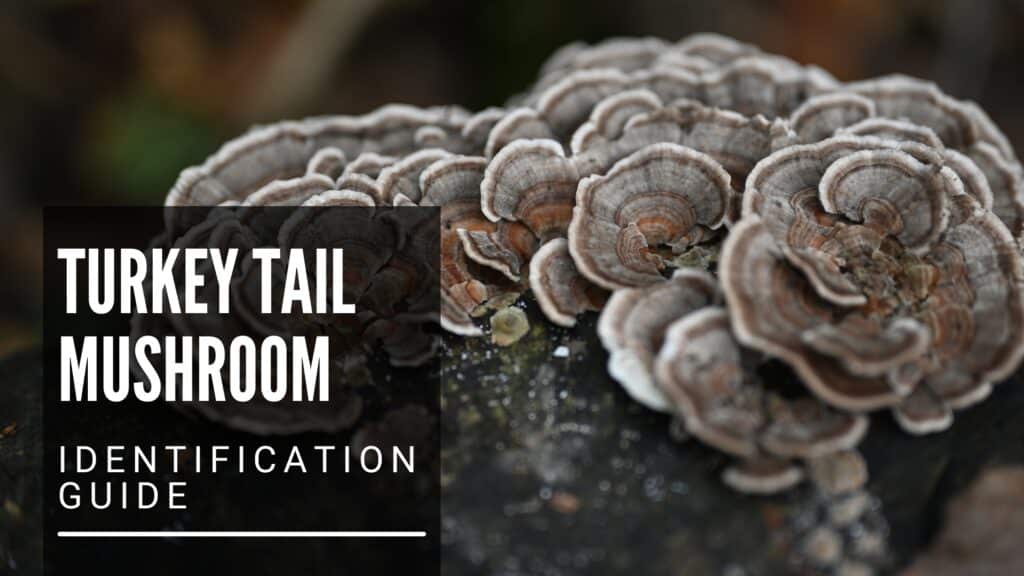Turkey Tail mushrooms, with their scientific name Trametes versicolor, are a fascinating and visually striking feature of wooded landscapes around the world. These mushrooms are easily recognizable by their colorful, fan-like patterns that mimic the appearance of a turkey’s tail, making them a favorite among mushroom foragers and nature enthusiasts alike.
Beyond their beauty, Turkey Tail mushrooms are prized for their significant health benefits. They have been used in traditional medicine for centuries, valued especially for their ability to enhance the immune system and offer potential anti-cancer properties.
In this guide, we’ll delve into the world of Turkey Tail mushrooms, providing you with all the information needed to identify these fungi confidently. Whether you’re a seasoned forager or a curious newcomer, understanding these mushrooms can add an enriching layer to your outdoor activities and health regimen.
Quick Summary:
- Scientific Name: Trametes versicolor
- Habitat: Grows on dead logs and trees
- Health Benefits: Supports the immune system, among other benefits

What is a Turkey Tail Mushroom?
Turkey Tail mushrooms thrive predominantly on decaying wood and are celebrated for their contribution to traditional medicine across various cultures. These fungi are characterized by their thin, fan-shaped caps, which typically display a mesmerizing array of concentric color bands ranging from browns and grays to blues and greens.
Key Characteristics for Identification
Identifying Turkey Tail mushrooms (Trametes versicolor) accurately involves detailed examination of several key characteristics. These features are crucial for distinguishing them from similar species and ensuring that foragers collect the correct type.
Pore Surface
The pore surface is a critical identifier for Turkey Tail mushrooms. When inspecting the underside of the mushroom, look for small, round, densely packed pores. These pores are typically whitish to light brown in color and should not exceed 5 pores per millimeter, which helps distinguish them from other species with larger or differently shaped pores. This pore structure is essential for confirming a true Turkey Tail, as it affects spore dispersion and ultimately the mushroom’s reproduction.
Surface Texture
The texture of the cap surface is another distinctive trait of the Turkey Tail mushroom. The cap typically exhibits a finely velvety texture, which can become more leathery and tough as the mushroom ages. This texture is not only a tactile marker but also influences the mushroom’s appearance, often affecting the sheen and color vibrancy on the surface. The velvety nature helps differentiate it from glossier lookalikes like Stereum ostrea, which has a smoother and more varnished appearance.
Color and Patterns
Turkey Tail mushrooms are renowned for their striking color patterns, which are perhaps their most recognizable feature. The cap exhibits concentric circles of varying colors, including shades of brown, gray, blue, and green. These colors are typically muted but can be quite vibrant, depending on environmental factors like moisture and sunlight exposure. The patterns resemble a turkey’s tail, giving the mushroom its common name. Each ring is subtly different in color and texture, creating a complex and visually appealing pattern that is not generally found in other mushroom species.
Margins and Shape
The edges of the Turkey Tail mushroom are usually slightly wavy and thin, contributing to its overall fan-like shape that can range from semi-circular to almost fully round when viewed from above. The margins are often lighter in color compared to the center, which can help in identification. The shape and margin texture can vary slightly based on the mushroom’s age and the humidity of its environment.
By carefully examining these aspects—pore surface, surface texture, color patterns, and the shape of the margins—enthusiasts and foragers can confidently identify Turkey Tail mushrooms and differentiate them from potential lookalikes in their natural habitat. This detailed inspection not only aids in safe foraging but also enriches the understanding of this fascinating fungal species.
Common Lookalikes and How to Distinguish Them
Turkey Tail mushrooms are often mistaken for a few other fungi species due to their similar appearances. However, knowing how to distinguish true Turkey Tails from these lookalikes is essential for both safe foraging and accurate identification.
Stereum ostrea (False Turkey Tail)

Stereum ostrea, commonly known as False Turkey Tail, is one of the most frequent lookalikes. Unlike the true Turkey Tail, this species does not have pores on its underside. Instead, it has a smooth, slightly hairy surface. The lack of pores is a definitive way to differentiate Stereum ostrea from Trametes versicolor. Additionally, False Turkey Tail tends to have a more rigid and wood-like texture, and its colors are often less vibrant, typically showing more muted yellows and oranges without the pronounced multicolored bands characteristic of true Turkey Tails.
Bjerkandera adusta (Smoky Polypore)

Another common lookalike is Bjerkandera adusta, or Smoky Polypore. This mushroom can sometimes mimic the coloration of Turkey Tails but is generally grayer and less colorful. One key distinguishing feature is its smoky-gray color, which becomes more pronounced as it ages, unlike the Turkey Tail which maintains a consistent color pattern throughout its lifecycle. Additionally, the pore surface of Smoky Polypore is typically gray and can secrete a blackish liquid when young—a feature not observed in Turkey Tails.
Trametes hirsuta (Hairy Bracket)

Trametes hirsuta, also known as the Hairy Bracket, bears a superficial resemblance to Turkey Tail mushrooms but can be differentiated by its distinctly hairy, rather than velvety, cap surface. The hairs on Trametes hirsuta give it a rough texture. It also typically exhibits less color variation, usually appearing in shades of white to gray without the colorful banding seen in Turkey Tails.
Understanding these distinctions is crucial for anyone interested in foraging or studying mushrooms, as it ensures the correct identification of Turkey Tail mushrooms and helps avoid the potential confusion caused by similar-looking species. This knowledge not only enhances foraging safety but also deepens appreciation of the diversity and complexity of fungi in natural ecosystems.
Why Try Turkey Tail Mushrooms?
Turkey Tail mushrooms offer a variety of benefits that make them a worthwhile addition to one’s health regimen or culinary experiences. Here are several reasons to consider incorporating Turkey Tail mushrooms into your routine, along with accessible alternatives to foraging.
Health Benefits
Turkey Tail mushrooms are renowned for their impressive array of health-promoting properties. They are rich in antioxidants and compounds like polysaccharopeptide, which may enhance the immune system and potentially offer anti-cancer benefits. These mushrooms have been used in traditional medicine across various cultures for centuries, primarily for boosting health and treating various ailments.
Connection with Nature
Foraging Turkey Tail mushrooms provides an excellent opportunity to connect with nature and enjoy the outdoors. It’s an engaging activity that can improve physical health and mental well-being by spending time in forested areas. For those interested in natural history and ecology, foraging also offers hands-on learning about local ecosystems and the role fungi play within them.
Accessible Alternatives to Foraging
While foraging can be a delightful and rewarding experience, it may not be accessible or appealing to everyone. Fortunately, Turkey Tail mushrooms are also available in several convenient forms that don’t require you to venture into the woods. Many health food stores and online retailers offer Turkey Tail mushrooms as dietary supplements, either in capsule form or as a powder that can be added to smoothies, teas, and other beverages. These products provide a straightforward and approachable way to enjoy the benefits of Turkey Tail mushrooms without the need for foraging.
Conclusion
This guide has provided you with the tools to confidently identify and utilize Turkey Tail mushrooms, enhancing both your foraging skills and your understanding of their health benefits. Whether you are an experienced forager or new to mushroom hunting, recognizing the distinct features of Turkey Tail mushrooms—like their unique pore surface and vibrant color patterns—can greatly enrich your outdoor adventures.
For those who prefer not to forage, Turkey Tail mushrooms are also available in convenient forms such as supplements and teas, making it easy to integrate their health benefits into your daily routine. These mushrooms offer a versatile way to boost your diet and support your health.
As you explore the world of mushrooms and share your discoveries, you contribute to a community that values and protects our natural environments. Whether through direct interaction in the forest or through culinary experiments at home, engaging with Turkey Tail mushrooms encourages a deeper appreciation of nature and sustainable practices.
References:
- He, Zhicheng, et al. “Polysaccharide-Peptide from Trametes Versicolor: The Potential Medicine for Colorectal Cancer Treatment.” Biomedicines, vol. 10, no. 11, 7 Nov. 2022, p. 2841, pubmed.ncbi.nlm.nih.gov/36359361/, https://doi.org/10.3390/biomedicines10112841. Accessed 19 Nov. 2022.

